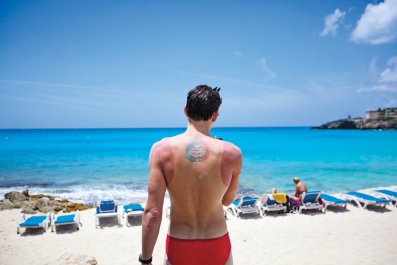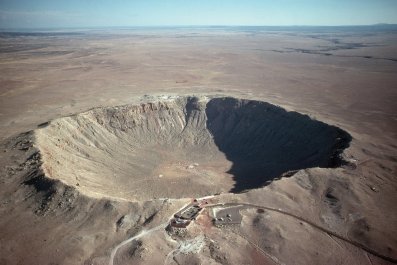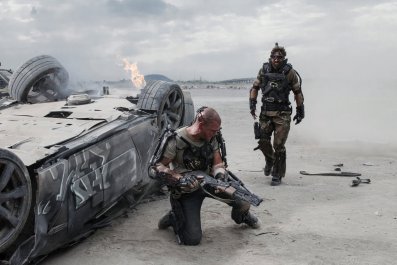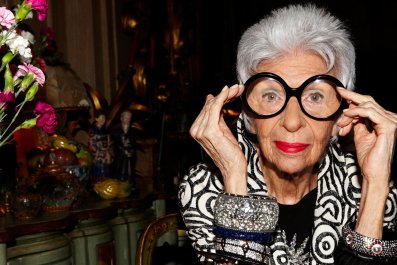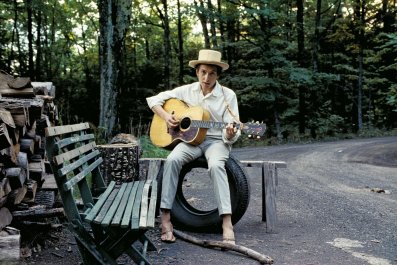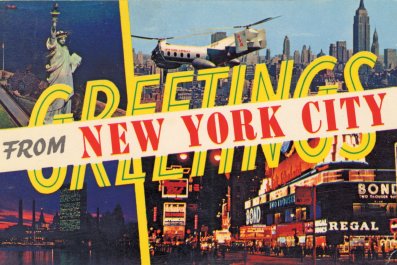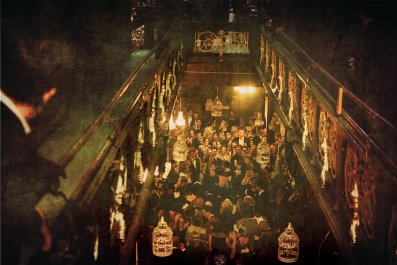You probably know what John Isner looks like, even if you don't know his name. Isner is that really tall guy—as in 6-foot-10, shoe-size-15 tall—who won the longest tennis match in history: an epic 11-hour-and-five-minute battle at Wimbledon a few years ago. Now, after barely losing an impressive two-set, two-tiebreak match to Rafael Nadal at the Western & Southern Open final in Cincinnati last week, the world's highest-ranked American enters the U.S. Open on what he calls a "pretty decent run," having won 16 of 20 matches. What better time for a dude from Greensboro, North Carolina, to make history by claiming his first grand-slam title?
Of course, it won't be easy. The all-American boy, who listens to classic rock like the Doobie Brothers to get pumped up and is an unabashed fan of the WWE, will have to get through tennis's big four at a grand slam, something that's been done only once in eight years. But 2013 has been a strange year. Roger Federer has dropped to seventh in the world. Rafael Nadal, despite an incredible 53–3 record, lost early at Wimbledon. Novak Djokovic hasn't won a title since April. Only Andy Murray, who broke the British drought at Wimbledon, has momentum.
Admittedly, it isn't exactly a great time for U.S. men's tennis. Earlier this month, for the first time in 40 years, there weren't any American men in the Association of Tennis Professionals' top-20 rankings. It was 10 years ago at Arthur Ashe Stadium that the last American man, Andy Roddick, won a major. But Isner isn't thinking about this. "I've never felt pressure to be the flag bearer for American tennis," he tells Newsweek.
Ranked 14th in the world, Isner has had a rough, injury-plagued year. He sat out the Australian Open with a bruised right knee, limped to early exits in minor tournaments, and failed miserably at the French Open. An injury to his left knee killed his chances at Wimbledon.
But when healthy and chasing down balls, the towering Isner moves less like a lean Shaq and more like the Oklahoma City Thunder's Kevin Durant. "Physically, he's more like a basketball player than a tennis player," says Angus Mugford, head of mental conditioning at the IMG Academy, with its famed Bollettieri tennis program, where the really young prodigies go to train. "A lot of players haven't gone up against guys like him."
Plus, you can never really count out anyone with a monster serve. And Isner's is blistering. This year, he's slapped a whopping 749 aces in 48 matches. Add a thundering, mechanically sound forehand and a propensity to end points early by rushing the net and Isner can beat the big four.
He dumped Federer on clay in 2012. He hasn't beaten Murray, but the two had a tight match in the U.S. Open's 2011 quarterfinals. In Cincinnati, he beat No. 1 ranked Djokovic (for the second time in his career) and dumped highly ranked Milos Raonic, Juan Martín del Potro, and Richard Gasquet. In the final, Nadal couldn't touch Isner's serve. The Spaniard was just a few points away from losing the match.
"No one wants to play Isner on tour," says retired pro Taylor Dent, who was known for his booming serve. "On any given day he can absolutely beat anybody."
There's a caveat to that statement: the man who can't be broken can't really break anyone else. "It's the return game," Isner says of his weakness. "These guys are so good, I'm not going to win matches playing defense." He's won only a dismal 12 percent of return games. It's why he's perpetually stuck in tiebreaks. Still, Isner likes his chances. "I have one pretty good weapon," he says, knowing his serve has a reputation. "These guys don't necessarily enjoy playing me."











